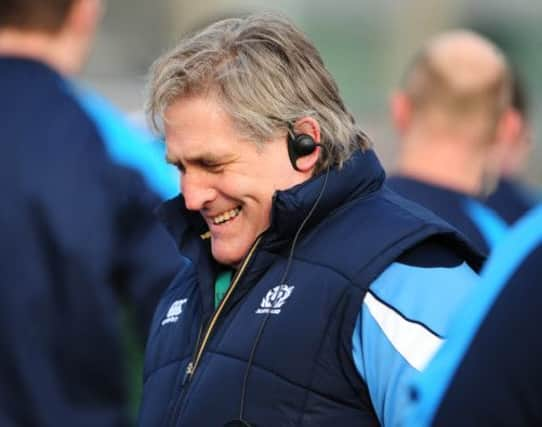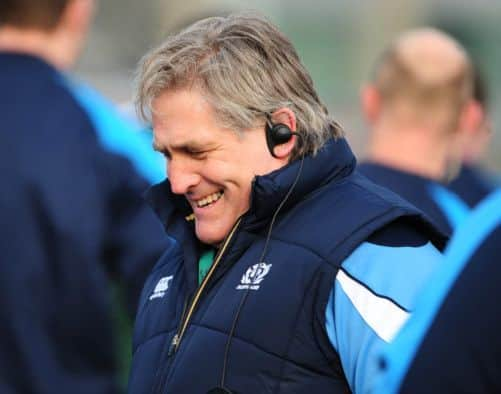Video: Johnson on Scotland’s defeat to South Africa


Despite Scotland going down 30-17 to South Africa in Nelspruit on Saturday, in what was the interim head coach’s fourth defeat in six Test matches since taking on the reins from Andy Robinson at the turn of the year, Johnson is convinced that the performance that a much-weakened Scots side turned in against South Africa should serve as a positive message for the game back home.
The Australian admitted that the squad were hugely disappointed at failing to hold on to a 17-6 lead midway through the second half and slipping off the intensity and accuracy in the final quarter as the Springboks steamed back into the match, but Johnson insisted that he could not fault his players for a display that went against pre-match predictions of a record hiding.
Advertisement
Hide AdAdvertisement
Hide AdHe said: “That was a quality performance and quality effort from our guys and that result didn’t reflect the performance. We continued with our injury problems [Scotland lost two stand-offs and a flanker to injury] but the resolve and the heart was still there. I’ve heard so much since I came about the resilience of Scottish people and, if that wasn’t most exemplified than out there, then I’m a blind man. That was an incredible effort.


“There is something underlying in this country [Scotland] and something underlying in the people, and I’m just coming to terms with that. I don’t know all the great qualities of Scottish people and the heritage, I don’t, and it would be arrogant for me to stand here and say I did. But there’s something there and I keep saying that if you want to be a great rugby side we have the ability to be great defenders and top-quality at the tackle area, and if we get those two areas right we’ll be a bloody good rugby side. We scored two good tries and probably left two or three on the pitch on the back-end of quality tackle work.
“It was superb and so the mantra will continue, and we have to get this right through Scottish rugby, that if we get this right then Scotland, at all age groups, will be competitive. We’ve got to stop thinking that we’re something else. We’re quality and we can do that. I’m passionate about it, because when we did it and we see the result, we can play footy.”
He went on to point to the technical aspects that let Scotland down in the opening tour match against Samoa, and resulted in a hugely disappointing 27-17 defeat, and which were significantly improved against the Boks, notably the physicality, aggression and accuracy at the tackle area and in defence.
Advertisement
Hide AdAdvertisement
Hide AdBut this is also Scotland. Players and supporters were left wondering on Saturday night “what if” in relation to the yellow-carding of lock Jim Hamilton when Scotland were holding a 17-13 lead, which became a 20-17 deficit by the time Al Kellock replaced him, and a great momentum swing.
As the dust settled, we were also asking how the team could play so poorly in key aspects of the game one week and look so much better seven days later. There were reasons. For example, against Samoa, Scotland fielded three players in the key 8,9,10 axis, in Johnnie Beattie, Greig Laidlaw and Tom Heathcote who had never played together before. Heathcote was making his first start and in the key defensive channel at outside centre he had a fresh-faced debutant, Alex Dunbar. Wing Tim Visser was caught out early on and Samoa, inevitably, worked a gameplan that perfectly exploited those frailties.
One week on, a few changes in personnel, and there was a far greater desire across the Scottish team, stemming in part at least from the fear of being humiliated if they were even a fraction off the pace, exemplified by Dunbar and Matt Scott, who led the defensive line superbly, broke the Bok line several times and scored a try each. The question now is whether they can learn from that performance and repeat it.
They could also do with a little luck as, just as inconsistency dogs Scottish attempts to be successful on the world stage, so does controversial refereeing. Scotland needed everything to go their way to claim a first-ever win over South Africa in their own land but decisions by match officials again proved hugely important to the match outcome.
Advertisement
Hide AdAdvertisement
Hide AdJim Hamilton did raise his hands and push opponent Eben Etzebeth in the face, the locks having been warring throughout the match, and it was foolish to give the officials the opportunity to consider a yellow card. South Africa were 17-13 behind at that point, with 52 minutes played, but went to 20-17 ahead by the time Scotland returned to their full complement, but did it need a South African television match official to make the decisions for the referee and his assistant, both of whom were close to the incident and neither deemed it a yellow card offence? “I’m never one to criticise officials,” said Johnson, insisting the fact it was a home-based official was irrelevant. “Nationality has nothing to do with it. The reality is that wasn’t a sin-binning and I just want to see consistency. I’ve watched a lot of rugby this year and I’ve seen that happen regularly, and there’s been no card for it.
“For the second week in a row the referee played God. We had injured players down and he was just playing the game. Last week it was concussion and this week a serious leg injury and he was just playing on. Officialdom is just out of control. You’ll very rarely hear me have a crack at referees. I usually don’t go there but I was bitterly disappointed for our boys and they gave me everything I asked so I have to come out swinging for them. Sometimes you have to say it. That wasn’t consistent.”
Johnson’s fury was beginning to ease as the team completed a four-hour bus journey from Nelspruit to the Sandton suburb of Johannesburg, as he turned his attentions to the latest injury-enforced choices he has to make ahead of Saturday’s final match against Italy, who lost 39-10 defeat to Samoa in Nelspruit.
Ryan Wilson, who stepped in after the squad lost openside flanker Kelly Brown, and versatile back Peter Horne are both on their way home with shoulder and knee injuries respectively, but other players are carrying heavy knocks.
However, Saturday restored some much-needed pride and, whoever takes the field against Italy in Pretoria on Saturday has the responsibility to prove that Scotland can also actually win.